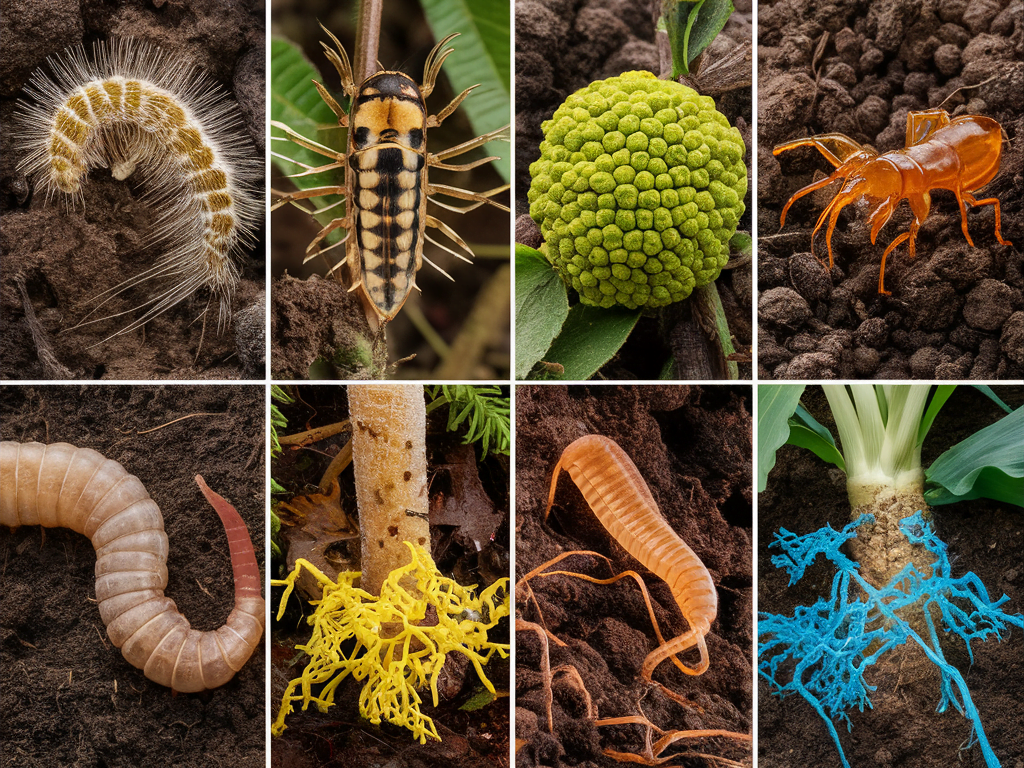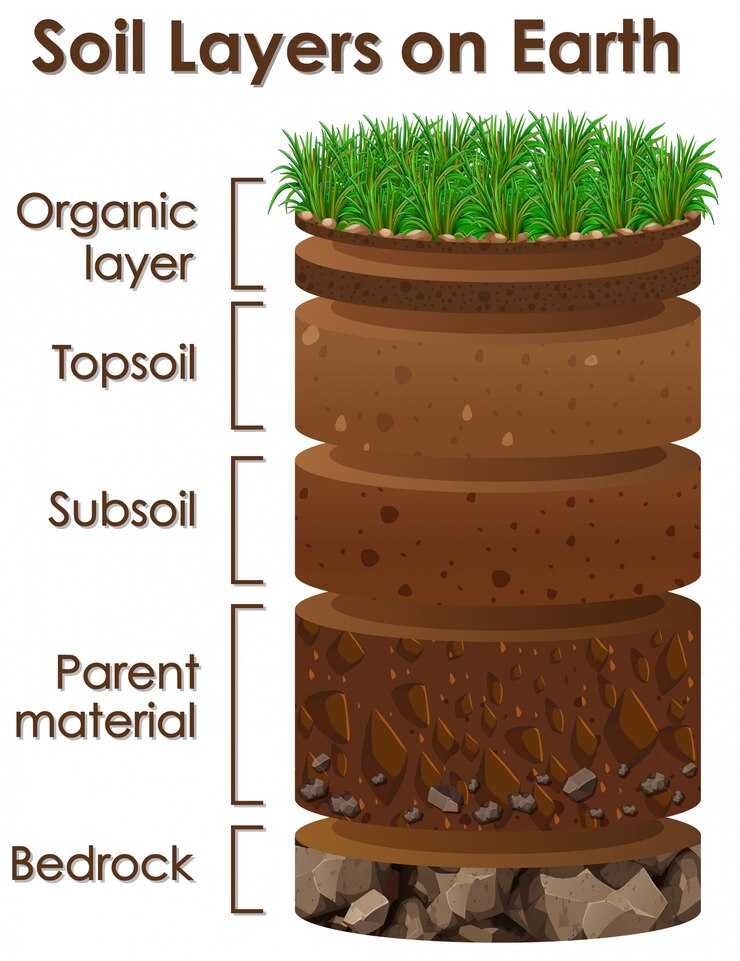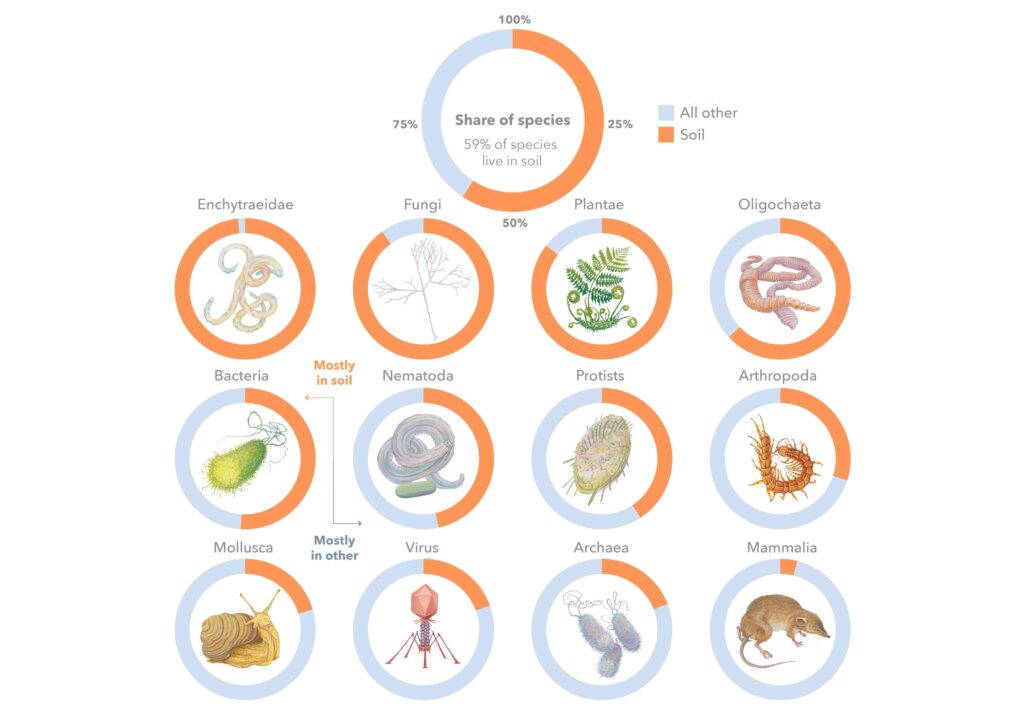When we think of biodiversity, our minds often wander to lush rainforests, coral reefs, or vast oceans teeming with life. However, there’s a hidden treasure trove of biodiversity right beneath our feet, in the soil. Recent studies have revealed that nearly 60% of all species call soil their home, making it the most biodiverse habitat on Earth. Soil biodiversity and ecosystem health are intrinsically linked, with a thriving community of soil organisms supporting crucial functions like nutrient cycling and water retention. Yet, the soil—the very ground we walk on—is one of the most biodiverse habitats on Earth. This underground world is home to trillions of organisms, from microscopic bacteria to wriggling earthworms, all working silently to keep ecosystems functioning.
This blog post takes you on a journey into the complex, hidden world of soil biodiversity—its composition, importance, threats, and what we can do to protect it. Whether you’re a student, nature lover, or sustainability advocate, understanding soil biodiversity is key to understanding life itself.

Soil is a hidden realm full of life that is often underestimated and neglected in the enormous tapestry of Earth’s ecosystems. All terrestrial life is based in a dynamic and biodiverse environment found beneath our feet. The soil is one of the planet’s most biodiverse environments—nearly 60% of all species live there, which is astounding.
What Is Soil Biodiversity?
Soil biodiversity refers to the variety of living organisms found within the soil ecosystem. This includes a vast range of microorganisms like bacteria, fungi, and protozoa, as well as larger organisms such as nematodes, insects, earthworms, and even small mammals. These organisms interact with each other and their environment to perform essential ecological functions, such as nutrient cycling, decomposition of organic matter, water filtration, and disease suppression. A single gram of healthy soil can contain billions of microbes, making it one of the most biologically rich environments. Soil biodiversity is crucial for maintaining soil health, supporting agriculture, and ensuring environmental sustainability.
These organisms are categorized into different groups based on their size and function:
- Microfauna: Bacteria, fungi, archaea, algae, and protozoa.
- Mesofauna: Springtails, mites, and nematodes.
- Macrofauna: Earthworms, ants, termites, and beetles.
Each group plays a vital role in maintaining the soil’s health, which in turn supports plant life and ecosystems above ground.
The Soil Ecosystem
The soil ecosystem is a dynamic, living system that supports an intricate web of organisms working together to sustain life above and below ground. Far from being just “dirt,” soil is a complex mix of minerals, organic matter, air, water, and countless living organisms. It hosts bacteria, fungi, protozoa, nematodes, arthropods, and earthworms—each playing a role in maintaining soil health and fertility.
These organisms contribute to vital ecosystem services such as decomposing organic material, recycling nutrients, enhancing soil structure, filtering water, and regulating pests and diseases. Plant roots also form symbiotic relationships with fungi (like mycorrhizae), boosting nutrient uptake and improving resilience to stress.
In a well-balanced soil ecosystem, every organism—from microscopic microbes to burrowing animals—has a role that influences soil productivity and the broader environmental balance. Understanding and preserving this biodiversity is essential for sustainable agriculture, climate regulation, and ecological health.
Soil is not just dirt; it’s a complex ecosystem that supports life in myriad ways. Here are some key players in this underground community:
- Fungi: Soil hosts an astounding 90% of the world’s fungi. These microscopic organisms play crucial roles in nutrient cycling, decomposition, and symbiotic relationships with plants.
- Plants and Roots: Approximately 86% of plant species have strong ties to soil. Their roots penetrate the ground, anchoring them and extracting essential nutrients.
- Bacteria: More than 50% of bacterial species thrive in soil. These tiny microbes contribute to nutrient availability, carbon cycling, and soil health.
- Earthworms and Snails: These soil-dwelling creatures, and other invertebrates, constitute about 20% of soil biodiversity. They aerate the soil, break down organic matter, and facilitate nutrient movement.
Why Soil Biodiversity Is So Important
Soil biodiversity is fundamental to life on Earth. It underpins the health of ecosystems, supports agricultural productivity, and plays a critical role in regulating the planet’s climate and nutrient cycles. The diverse community of organisms living beneath our feet—ranging from bacteria and fungi to insects and earthworms—drives essential processes that sustain plants, animals, and humans.
One of the key roles of soil biodiversity is nutrient cycling. Microbes break down organic matter like dead plants and animals, converting it into nutrients that plants can absorb. This natural recycling system reduces the need for chemical fertilizers and ensures the fertility of the soil over time.
Additionally, soil organisms improve soil structure. Earthworms and arthropods aerate the soil by burrowing through it, creating channels that enhance water infiltration and root penetration. This leads to better crop yields and reduced erosion.
Soil biodiversity also acts as a natural defense system. Beneficial microbes outcompete harmful pathogens, reducing the need for pesticides. Some soil organisms even form symbiotic relationships with plant roots, boosting their immunity and helping them survive harsh environmental conditions.
Beyond agriculture, soil life helps with carbon storage. Microbes capture and store carbon in the soil, mitigating the effects of climate change. Soils are, in fact, one of the largest carbon sinks on the planet.

Preserving soil biodiversity means protecting the foundation of food security, environmental sustainability, and climate resilience. When we care for the life in the soil, we support the health of everything above it.
- Climate Change: Soil organisms influence climate change feedback. For instance, they regulate greenhouse gas emissions by decomposing organic matter and affecting soil carbon storage.
- Food Security: 95% of our food is grown in soil. Understanding soil biodiversity is crucial for sustainable agriculture and ensuring global food security.
- Human Health: Soil microbes play a role in human health. They can enhance our immune system and even impact our mental well-being.
The Role of Soil Biodiversity in Agriculture
Soil biodiversity plays a crucial, often invisible role in sustaining agricultural productivity and resilience. The living organisms within soil—microbes, fungi, earthworms, nematodes, and insects—form a complex web of life that directly influences plant health, crop yield, and the sustainability of farming systems.
At the heart of this relationship is nutrient availability. Microorganisms decompose organic matter, releasing essential nutrients like nitrogen, phosphorus, and potassium in forms that plants can readily absorb. This natural process reduces dependency on synthetic fertilizers and promotes a more balanced nutrient profile in the soil.
Soil biodiversity also enhances plant growth and resilience through symbiotic relationships. For example, mycorrhizal fungi attach to plant roots and extend their reach, helping plants access water and minerals from distant parts of the soil. In return, the plant supplies the fungi with carbohydrates. Such partnerships improve drought tolerance, disease resistance, and overall plant vigor.
Another vital function is pest and disease suppression. Healthy, diverse soil ecosystems contain beneficial bacteria and fungi that inhibit the growth of harmful pathogens. These organisms can outcompete or directly attack crop-threatening pests, reducing the need for chemical pesticides and fostering a more balanced, self-regulating system.
Soil organisms also improve soil structure, which is critical for water retention and root development. Earthworms, for instance, mix and aerate the soil as they move through it, creating channels that improve drainage and reduce compaction, factors that are key to strong, deep-rooted crops.
By supporting a thriving belowground ecosystem, farmers can improve the sustainability, resilience, and productivity of their agricultural practices. Promoting soil biodiversity through techniques like crop rotation, cover cropping, reduced tillage, and organic amendments not only improves yields but also helps build long-term soil health and ecological balance.
Threats to Soil Biodiversity
Despite its vital role in ecosystem functioning and agriculture, soil biodiversity is under increasing threat from human activities and environmental changes. These threats can degrade the health of the soil and disrupt the delicate balance of its living organisms, leading to long-term consequences for food security, water quality, and climate resilience.
One of the most significant threats is intensive agriculture and chemical use. Excessive application of synthetic fertilizers, herbicides, and pesticides can kill beneficial soil organisms or disrupt their interactions. Monoculture farming—growing the same crop repeatedly in a single area—also reduces habitat diversity in the soil, limiting the range of organisms that can survive and thrive.
Soil erosion and compaction are major physical threats. Deforestation, overgrazing, and improper plowing techniques remove the protective topsoil layer and compact the soil beneath, making it harder for air, water, and organisms to move freely. This damages soil structure and reduces the ability of microbes and invertebrates to perform essential functions like nutrient cycling and organic matter breakdown.
Pollution—especially from heavy metals, industrial waste, and untreated sewage—introduces toxic substances into the soil that can poison or sterilize microbial communities. Likewise, plastic pollution, particularly in the form of microplastics, is increasingly found in agricultural soils and can interfere with soil fauna and microbial processes.
Climate change poses another severe threat. Rising temperatures, shifting precipitation patterns, and extreme weather events can alter soil moisture levels and disrupt the natural rhythms of soil organisms. Droughts reduce microbial activity, while flooding can suffocate soil life by depleting oxygen. Additionally, increased atmospheric carbon and nitrogen deposition can skew nutrient balances in ways that harm biodiversity.
Lastly, urbanization and land use change lead to soil sealing, when land is covered by impermeable surfaces like concrete and asphalt, which permanently destroys the soil ecosystem in those areas. Even land conversion for infrastructure or industry fragments habitats and displaces soil organisms.
Protecting soil biodiversity requires sustainable land management, responsible farming practices, pollution control, and broader climate action. By recognizing the value of the hidden life beneath our feet, we can take meaningful steps to preserve it for future generations.
Protecting the Hidden Life Beneath Our Feet
Soil is more than just dirt—it’s a living, breathing ecosystem teeming with an incredible variety of organisms, from microscopic bacteria and fungi to earthworms, insects, and other invertebrates. These creatures perform essential functions such as decomposing organic matter, cycling nutrients, filtering water, and supporting plant growth. Protecting this hidden life is crucial not only for agriculture but for the health of our entire planet.
Sustainable farming practices play a key role in soil conservation. Techniques like crop rotation, cover cropping, and reduced tillage help maintain soil structure, improve fertility, and foster biodiversity. Using organic fertilizers and natural pest control methods minimizes the chemical load that can harm beneficial soil organisms.
Composting is another powerful tool. By returning organic matter to the soil, compost enhances microbial activity and soil health. Likewise, agroforestry—integrating trees and shrubs into farmland—can reduce erosion, increase organic matter, and provide microhabitats for soil fauna.
Reducing pollution is essential. Limiting the use of plastics, properly managing industrial and household waste, and preventing chemical runoff from reaching soil ecosystems can significantly decrease the toxic burden on the subterranean world.
Urban planning that preserves green spaces and uses permeable surfaces helps mitigate soil sealing and allows natural infiltration of water and air—critical for soil organisms to survive.
Education and policy also play a role. Raising awareness about soil biodiversity among farmers, students, and the public encourages stewardship. Governments and organizations can implement policies and incentives for regenerative agriculture and land restoration projects that protect or rehabilitate degraded soils.
Ultimately, protecting soil biodiversity is about valuing the invisible foundation of life. Healthy soils support resilient ecosystems, abundant food systems, and climate stability. By respecting and nurturing the life beneath our feet, we safeguard the well-being of generations to come.
Challenges and Conservation Efforts
Soil biodiversity is threatened by several factors despite its significance, such as habitat loss, pollution, deforestation, and intensive agricultural activities. Scientists and conservationists are pushing for sustainable soil management techniques that support ecosystem resilience and biodiversity conservation because they understand how important soil is to life as we know it. Crop rotation, cover crops, and decreased tillage are examples of agroecological techniques used in these initiatives to improve soil health and biodiversity while preserving agricultural output.
Despite its importance, the soil remains understudied. Researchers estimate that there could be up to 100 billion species on Earth, but we’ve barely scratched the surface. Soil biodiversity faces threats from pollution, deforestation, and climate change.

A World Worth Protecting
Beneath our feet lies a vibrant, dynamic world that too often goes unnoticed—a world filled with microscopic organisms, tiny insects, fungi, earthworms, and countless other forms of life that quietly sustain ecosystems, grow our food, and regulate the Earth’s climate. This hidden universe, known as soil biodiversity, is essential for the survival of nearly all life on land, yet it faces increasing threats from human activity and environmental degradation.
Soil is not inert; it’s alive. A single teaspoon can contain more living organisms than there are people on Earth. These life forms perform critical functions—decomposing organic matter, cycling nutrients, suppressing disease, purifying water, and maintaining the structure and fertility of soil. Without them, ecosystems would collapse, and agriculture would falter.
However, deforestation, pollution, climate change, industrial agriculture, and urban expansion are disrupting this underground ecosystem. As we degrade our soil, we lose its biodiversity—and with it, the resilience and productivity of our natural and food systems.
Protecting soil biodiversity isn’t just an environmental duty—it’s a shared responsibility for the future of humanity. Through sustainable land management, education, innovation, and policy action, we can restore soil health and protect this unseen world. From farmers adopting regenerative practices to scientists mapping underground ecosystems and individuals composting at home—every action counts.
Soil is more than just the ground we walk on—it is the foundation of life. Preserving its biodiversity means safeguarding food security, climate stability, and the planet’s ecological balance. It truly is a world worth protecting.
Feel free to explore the soil beneath your feet—it’s a world waiting to be discovered!
Read Also
- Soils of India
- Monsoon Patterns and Climate Change in India
- Agriculture of India and Maharashtra
- Understanding the Difference Between Weather and Climate
- Sustainable living tips
- Sustainable shopping habits
- Waste-Free Cooking and Meal Planning
- 10 Most Biodiverse Countries
- 10 Unique Hybrid Animals Created by Humans
- Exploring the Most Remote Cohorts of the World
- Niue: A Pristine Paradise Fights for its Future
- 10 best national parks for jungle safari in India
- Top Eco-Tourism Destinations for Nature Lovers
- How Do Indigenous cohorts Live in the Amazon Rainforest?
- Drylands: The Vital Lifeline for Over 2 Billion People
Frequently Asked Questions (FAQs)
A. Soil biodiversity refers to the variety of living organisms that inhabit soil ecosystems. It includes bacteria, fungi, plants, invertebrates, and other microorganisms that play essential roles in nutrient cycling, decomposition, and overall soil health.
A. Soil biodiversity is crucial for maintaining ecosystem health and functioning. Soil organisms contribute to nutrient cycling, decomposition, soil structure formation, and plant growth, thereby supporting terrestrial ecosystems and agricultural productivity.
A. These tiny organisms are the hidden heroes of our planet. They decompose organic matter, creating nutrients for plants, aerate the soil, and contribute to overall ecosystem health. Healthy soil with high biodiversity translates to fertile land, clean water, and a thriving environment.
A. Deforestation, intensive agriculture practices, and overuse of pesticides disrupt the delicate balance of soil life. Loss of biodiversity in the soil can lead to a decline in fertility, increased erosion, and a domino effect on the overall health of ecosystems
A. Conservation efforts to protect soil biodiversity include promoting sustainable land management practices such as agroecology, organic farming, reduced tillage, crop rotation, and the use of cover crops. These practices aim to enhance soil health, minimize soil erosion, and preserve biodiversity while maintaining agricultural productivity.







Can you be more specific about the content of your article? After reading it, I still have some doubts. Hope you can help me.
Your point of view caught my eye and was very interesting. Thanks. I have a question for you.